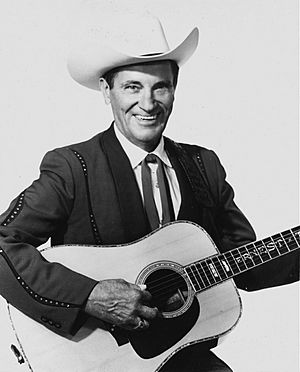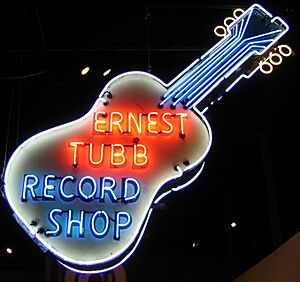Ernest Tubb facts for kids
Quick facts for kids
Ernest Tubb
|
|
|---|---|

Tubb c. 1964
|
|
| Background information | |
| Birth name | Ernest Dale Tubb |
| Also known as | The Texas Troubadour |
| Born | February 9, 1914 Crisp, Texas, U.S. |
| Died | September 6, 1984 (aged 70) Nashville, Tennessee, U.S. |
| Genres | |
| Occupation(s) | Singer-songwriter, bandleader |
| Instruments | Vocals, guitar |
| Years active | 1936–1982 |
| Labels | Bluebird, Decca, First Generation |
| Associated acts |
|
Ernest Dale Tubb (born February 9, 1914 – died September 6, 1984) was an American singer and songwriter. He was known as the Texas Troubadour. Ernest Tubb was one of the first big stars of country music.
His most famous song was "Walking the Floor Over You" (1941). This song helped make the honky tonk style of music popular. In 1948, he was the first to record a hit version of "Blue Christmas". This song later became very famous when Elvis Presley sang it. Another popular song by Tubb was "Waltz Across Texas" (1965). People still use this song for waltz lessons in Texas. In the early 1960s, he sang duets with Loretta Lynn, including their hit "Sweet Thang". Ernest Tubb is a member of the Country Music Hall of Fame.
Contents
Biography
Early Life and Music Dreams
Ernest Tubb was the youngest of five children. He was born on a cotton farm near Crisp, Texas. His family worked on farms across Texas. From a young age, Ernest was inspired by country singer Jimmie Rodgers. He spent his free time learning to sing, yodel, and play the guitar.
When he was 19, he got a job singing on a radio station in San Antonio. Later, he moved to San Angelo, Texas. There, he had a 15-minute live radio show. To support himself, he also delivered beer. During World War II, he even wrote a song called "Swell San Angelo."
Becoming a Star
In 1936, Ernest Tubb reached out to Jimmie Rodgers' widow. Rodgers had passed away in 1933. A friendship grew, and she helped Tubb get a recording contract with RCA. His first two songs were not very successful. After a throat surgery in 1939, his singing style changed. He then focused more on writing songs.
In 1940, he joined Decca Records. He tried singing again, and his sixth song with Decca became a huge hit. This song was "Walking the Floor Over You." It sold over one million copies! This made Ernest Tubb a big star.
In February 1943, Tubb became a regular performer at the Grand Ole Opry. This is a famous country music show. He also formed his band, the Texas Troubadours. Ernest Tubb stayed on the Opry for 40 years. He also hosted his own radio show called Midnite Jamboree every Saturday night. In 1947, he was the main performer at the first Grand Ole Opry show in Carnegie Hall in New York City.
Ernest Tubb always worked with talented musicians. Guitarists like Jimmy Short and Billy Byrd helped create his unique sound. Billy Byrd added jazzy guitar parts that became a signature of Tubb's songs. Even his producer, Owen Bradley, played piano on many of his recordings.
In 1949, Tubb teamed up with the famous Andrews Sisters. They recorded country songs together. One popular song was "I'm Bitin' My Fingernails and Thinking of You." The Andrews Sisters were used to a different singing style. Ernest Tubb had his own unique timing, but they made it work!
Ernest Tubb was known for his unique singing voice. He would often joke about it himself. He said that most people in bars would think they could sing better than him, and he agreed!
Later Career and Legacy
In the 1960s, Ernest Tubb had one of the best bands in country music. It included amazing guitarists like Leon Rhodes and Buddy Emmons. Buddy Emmons later started his own company making steel guitars. Buddy Charleton was another fantastic steel guitarist who played with Tubb for many years.
Starting in 1965, he hosted his own TV show called The Ernest Tubb Show. It ran for three years. That same year, he was inducted into the Country Music Hall of Fame. In 1970, he also joined the Nashville Songwriters Hall of Fame.
Ernest Tubb had very loyal fans. They followed his career even after his songs stopped being big hits. He continued to perform at the Grand Ole Opry. He also kept hosting his Midnite Jamboree radio show from his record shop.
In 1979, he released an album called The Legend and the Legacy. On this album, he sang duets with many other famous country singers. In 1980, he appeared as himself in the movie Coal Miner's Daughter, which was about Loretta Lynn's life.
Ernest Tubb's singing voice stayed strong for most of his life. Later, he became ill with emphysema, a lung condition. Even with his illness, he still performed over 200 shows a year. He would carry an oxygen tank on his tour bus. After every show, he would meet and greet every fan. Health problems finally stopped his performances in 1982.
Death
Ernest Tubb made his last appearance on the Grand Ole Opry on August 15, 1982. He passed away on September 6, 1984, in Nashville, Tennessee, due to emphysema. He is buried in Nashville.
His Impact
Ernest Tubb was inducted into the Texas Country Music Hall of Fame in 1999. In 2003, CMT ranked him number 21 on their list of the 40 Greatest Men of Country Music.
Many of Ernest Tubb's family members also became musicians. His son, Justin Tubb, was a popular country singer and songwriter. Justin's sons, Carey and Zachary, also became musicians. Ernest Tubb's nephew, Billy Lee Tubb, was his lead guitarist for a short time. Another nephew, Glenn Douglas Tubb, wrote many hit songs for other famous artists.
Several musicians who played in Ernest Tubb's band also became successful country stars. These include Cal Smith, who sang "Country Bumpkin", and Jack Greene, who sang "There Goes My Everything".
The Midnite Jamboree radio show that Ernest Tubb started in 1947 is still on the air today! It is recorded from a stage at his record shop. The song "Set 'Em Up Joe" by Vern Gosdin was a tribute to Ernest Tubb's music. The Ernest Tubb Record Store, which he founded in 1947, is still open in Nashville.
Discography
See also
 In Spanish: Ernest Tubb para niños
In Spanish: Ernest Tubb para niños



